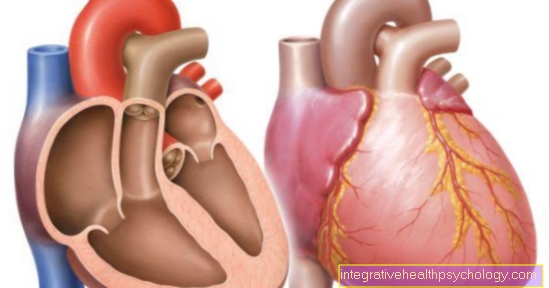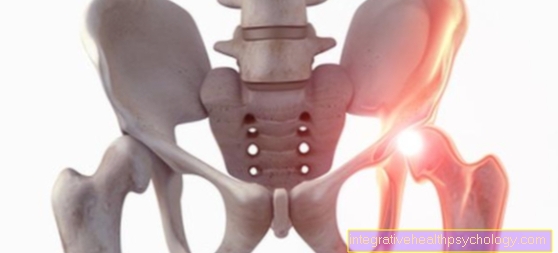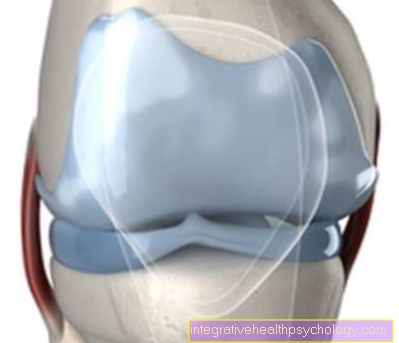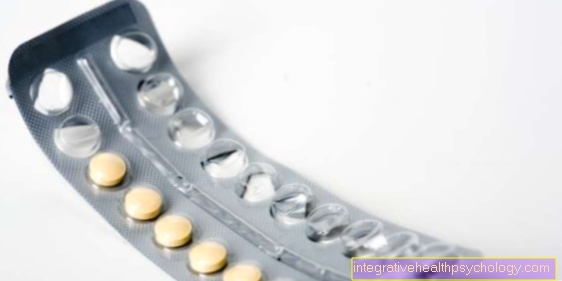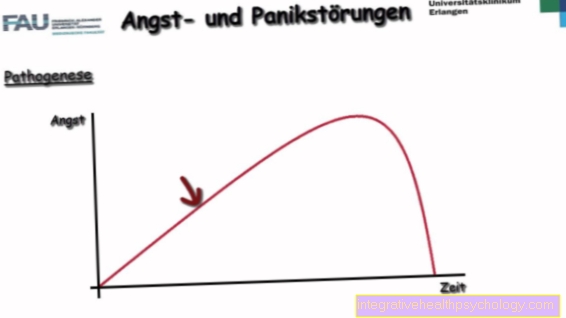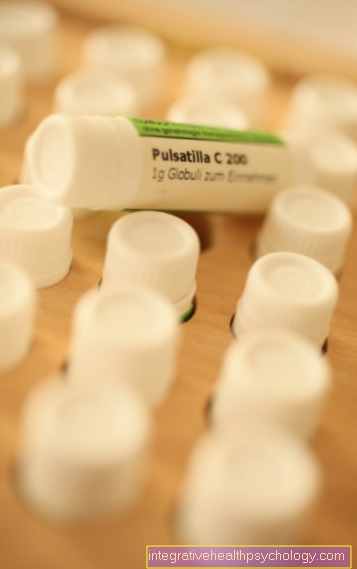Greater omentum
Anatomy and function
The Greater omentum means "large net" and denotes a duplication of the peritoneum (peritoneum). It is attached to the underside of the stomach (great curvature) and the horizontal part of the large intestine (transverse colon) and hangs down like an apron. As a result, it covers the deep abdominal organs such as the entire small intestine and the transverse large intestine. It is evolutionary Greater omentum caused by the rotation of the stomach. It was formed from the posterior connection between the stomach and the back wall of the body cavity and was greatly elongated by the rotation and tilting of the stomach during embryonic development.

Due to the size and superficial location of the Greater omentum the organs below are protected. It is mainly used for upholstery. In addition, there is Greater omentum made of adipose tissue and contains lymph nodes that serve the immune defense. These are mostly secondary to the Greater omentum on. Since this structure is very mobile and displaceable, it can easily stick or agglutinate the Greater omentum with the peritoneum of the neighboring organs. This is particularly favored by local inflammation. Movement of the organs is restricted. The resulting connections between organs and Greater omentum will be as Brides designated. They can become very dangerous if they entrap the organs below. A Bride can, for example, be an obstacle to the passage of the intestine and lead to blockages and even an intestinal obstruction (Ileus) to lead.
You can find more information on adhesions / clamps at: Adhesions in the abdomen
On the other hand, it can Greater omentum due to its large number of immune defense cells and its ability to cover an organ to Contain inflammation contribute. The spread and thus the danger of a life-threatening one Peritonitis (Peritonitis) is reduced.
It also helps Greater omentum relevant to the Fluid regulation of the abdominal cavitybecause it can absorb and release a lot of liquid over its large surface.
Last has Greater omentum also an important function as Fat storage of the body. It can serve as an energy reserve in times of reduced food intake. In overweight people that is Greater omentum often enlarged and a few inches thick. This also makes it an obstacle during abdominal surgery. In this context, it often ends up in a different position than it originally was.
Tapes
To the Greater omentum In addition to the prominent apron-shaped fatty and connective tissue that hangs down from the large curvature of the stomach, some ligaments are also counted. These connect the neighboring organs with one another.
The Gastrocolic ligament is a ligament structure that runs between the bottom of the stomach and the large intestine. The tape starts on the horizontal side of the colon frame. It contains vessels that supply parts of the intestine. This band also forms the front of the Omental bursa. This is a gap or a small cave in the peritoneum.
The Gastrophrenic ligament runs between the upper portion of the stomach, also called the Fundus and the diaphragm.
In addition, that educates Gastrosplenic ligament a share of the Greater omentum. This band runs from the bottom of the stomach to the Splenic hilum, the area of the spleen, the entry and exit port for the vessels. This band fixes the spleen in its position and contains vessels to supply the stomach.
Resection

The surgical removal of the Greater omentum is called Omentectomy designated. It can be done through open surgery or through a minimally invasive procedure using a laparoscopy (Laparoscopy) occur and is either due to an enforcement (infiltration) of the Greater omentum removed by a malignant tumor or due to extreme enlargement in the case of pronounced overweight. It can be separated either directly below the stomach or just below the intestine.
The resection creates more space for the other abdominal organs, so that possible entrapment is eliminated. However, the abdominal organs are characterized by the absence of the Greater omentum less protected and padded. In addition, with the removal of the Greater omentum an important collection point for immune defense cells in the abdominal cavity was lost. After a Omentectomy should therefore pay particular attention to the signs of incipient peritonitis (Peritonitis) be respected. The clinical symptoms of such peritonitis are severe pain, defensive tension in the abdomen and high fever.
Metastases
In the case of tumors in the abdominal cavity and the pelvis, metastasis, i.e. tumor settlement in the Greater omentum, come. Especially like to metastasize the tumor cells of ovarian cancer into the fatty peritoneum duplication, because it contains many nutrients and energy, so that optimal growth conditions for the Metastases given are. They can either occur individually or all of them Greater omentum into a hard plate Metastases transform. Researchers now even assume that certain messenger substances in the fat cells of the Greater omentum attract the tumor cells. A particularly unfavorable aspect is the mostly late symptoms of ovarian cancer and the resulting symptoms Metastases. Early symptoms are not recognizable or are very unspecific, so that most women only consult a doctor because of an increase in abdominal circumference as a result of the growth of the tumor. In addition to ovarian cancer, other tumors can also be found in the Greater omentum metastasize. These include colon cancer, pancreatic cancer and stomach cancer. A combination of chemotherapy and removal of the tumor is often a suitable therapy method, depending on the initial tumor. Depending on the location and size of the Metastases these can also be removed. At a metastasis in the Greater omentum becomes a complete Omentectomy carried out.
Read more on this topic: Peritoneum metastases


